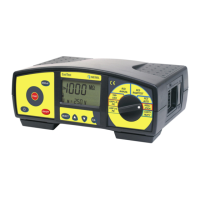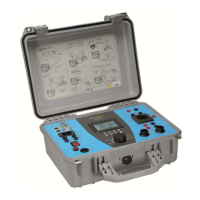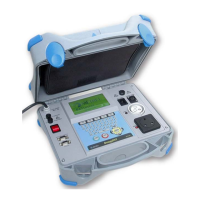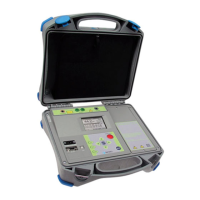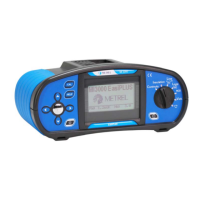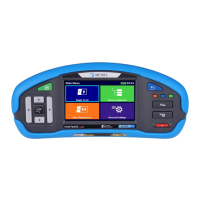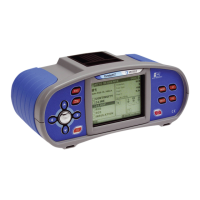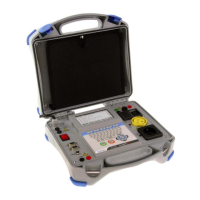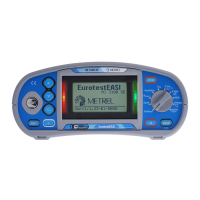Do you have a question about the METREL MI 2088 and is the answer not in the manual?
Describes the Earth - Insulation Tester as a professional, multifunctional, portable instrument for various measurements.
Provides essential safety warnings to ensure operator safety and instrument integrity during use.
Details the parameters measurable by the instrument, including Earth Resistance, Continuity, and Insulation Resistance.
Lists the European safety and EMC standards the instrument is designed according to.
Details the layout and controls of the instrument's front panel, including buttons and display.
Explains the different connectors on the instrument for test cables and PC communication.
Illustrates and describes features on the bottom side of the instrument, such as carrying strips and battery compartment.
Lists standard/optional accessories and demonstrates carrying methods for the instrument.
Provides detailed steps and warnings for performing Insulation Resistance measurements on various objects.
Explains the procedure for measuring voltage, useful for locating faults and safety checks.
Details the process for measuring continuity of protection conductors before mains voltage connection.
Explains the use of the continuity function for terminal connections and equipment repair.
Covers Earth Resistance measurement using internal generator via four-lead, clamp, and two-clamp methods.
Explains how to measure Earth Resistivity, crucial for defining earthing system parameters.
Details the procedure for measuring current using a test clamp, including leakage and phase current.
Guides the user on measuring the breakdown voltage of varistor over-voltage protection devices.
Explains the procedure for storing test results in the instrument's memory for documentation.
Details the steps required to recall previously stored test results from the instrument's memory.
Provides instructions on how to erase all stored results or specific individual results.
Explains how to connect the instrument to a PC for transferring test results using RS 232 communication.
Guides the user on how to perform a factory reset on the instrument to restore initial settings.
Details how to configure general settings like mains voltage frequency and Earth Resistivity units.
Provides instructions on battery replacement, insertion, and monitoring of battery condition.
Explains the location, type, and replacement procedure for the instrument's fuse.
Offers guidance on how to clean the instrument's exterior safely and effectively.
Recommends calibration frequency for maintaining instrument accuracy and performance.
Provides information on obtaining service and repairs, including producer's contact details.
Lists detailed technical specifications, ranges, resolutions, and accuracies for each measurement function.
Summarizes general characteristics of the instrument, including power, dimensions, environment, and connection types.
Describes the Earth - Insulation Tester as a professional, multifunctional, portable instrument for various measurements.
Provides essential safety warnings to ensure operator safety and instrument integrity during use.
Details the parameters measurable by the instrument, including Earth Resistance, Continuity, and Insulation Resistance.
Lists the European safety and EMC standards the instrument is designed according to.
Details the layout and controls of the instrument's front panel, including buttons and display.
Explains the different connectors on the instrument for test cables and PC communication.
Illustrates and describes features on the bottom side of the instrument, such as carrying strips and battery compartment.
Lists standard/optional accessories and demonstrates carrying methods for the instrument.
Provides detailed steps and warnings for performing Insulation Resistance measurements on various objects.
Explains the procedure for measuring voltage, useful for locating faults and safety checks.
Details the process for measuring continuity of protection conductors before mains voltage connection.
Explains the use of the continuity function for terminal connections and equipment repair.
Covers Earth Resistance measurement using internal generator via four-lead, clamp, and two-clamp methods.
Explains how to measure Earth Resistivity, crucial for defining earthing system parameters.
Details the procedure for measuring current using a test clamp, including leakage and phase current.
Guides the user on measuring the breakdown voltage of varistor over-voltage protection devices.
Explains the procedure for storing test results in the instrument's memory for documentation.
Details the steps required to recall previously stored test results from the instrument's memory.
Provides instructions on how to erase all stored results or specific individual results.
Explains how to connect the instrument to a PC for transferring test results using RS 232 communication.
Guides the user on how to perform a factory reset on the instrument to restore initial settings.
Details how to configure general settings like mains voltage frequency and Earth Resistivity units.
Provides instructions on battery replacement, insertion, and monitoring of battery condition.
Explains the location, type, and replacement procedure for the instrument's fuse.
Offers guidance on how to clean the instrument's exterior safely and effectively.
Recommends calibration frequency for maintaining instrument accuracy and performance.
Provides information on obtaining service and repairs, including producer's contact details.
Lists detailed technical specifications, ranges, resolutions, and accuracies for each measurement function.
Summarizes general characteristics of the instrument, including power, dimensions, environment, and connection types.
| Test Voltage | 50 V, 100 V, 250 V, 500 V, 1000 V |
|---|---|
| Phase Sequence | Yes |
| Power and THD | Yes |
| Testing of Insulation Monitoring Devices (IMDs) | Yes |
| Data Logging | Yes |
| PC Software | Yes |
| Power Supply | Rechargeable battery |
| Dimensions | 250 x 120 x 70 mm |
| Type | Multifunction Installation Tester |
| Harmonics Analysis | Yes |
| Touch Voltage | Yes |
| Illumination | Yes |
| Display | LCD |
| Measurement Category | CAT III 600 V, CAT IV 300 V |
| Operating Temperature | -10 °C ... +50 °C |
| Storage Temperature | -20°C to 60°C |
| Safety Standards | EN 61557 |
